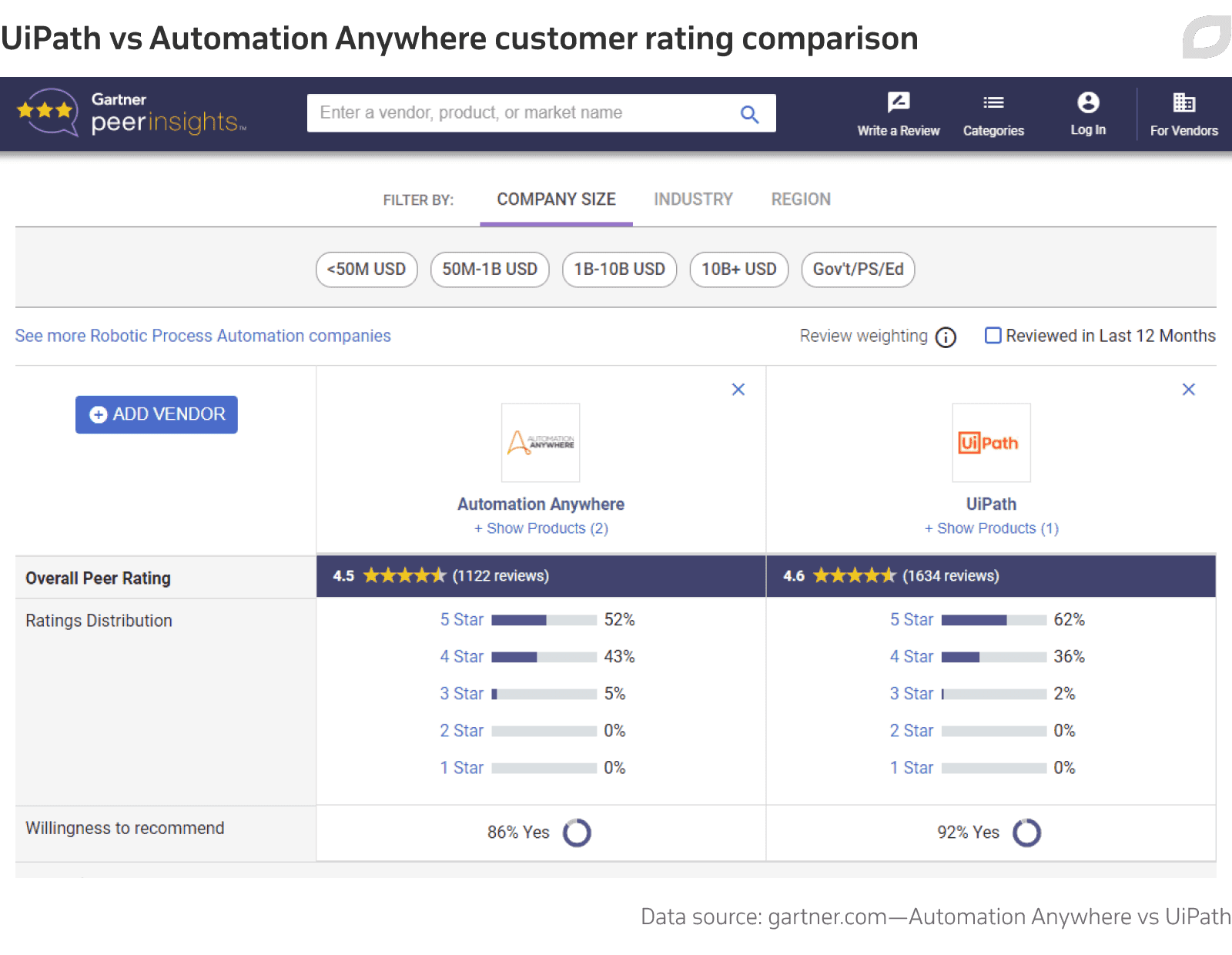There isn't much to argue about the benefits of RPA across any sector or business function of the modern economic spectrum, including real estate, automotive industry, healthcare, insurance, banking, and HR. This ensemble of automation technologies has proven highly effective in improving productivity and accuracy, cutting costs, delivering a better customer experience, and freeing employees from performing dehumanizing and time-consuming tasks.
What's not that obvious and straightforward, on the other hand, is choosing the best platform to build proper RPA solutions fitting your company's needs.
Nowadays, it's possible to choose among a pretty wide menu of different platforms and services. However, the undisputed leaders of the RPA market are definitely UiPath and Automation Anywhere. According to IDC’s 2020 estimates, indeed, UiPath takes first place with a remarkable market share of 27.1%, followed by Automation Anywhere with 19.4%.
However, the two competitors really run neck to neck, as you can see in Gartner's 2021 Magic Quadrant that takes into account the most relevant features and capabilities of major RPA platforms today.
But what makes them so popular, and which characteristics differentiate them from each other? We will try to answer these questions and understand which may be the best option to automate your business processes.
What makes them different (or not)?
Before the actual comparison between UiPath and Automation Anywhere, it is worth making a premise. The two competitors typically try to replicate each other's strengths, often ending up having more points in common than differences. A striking example is their deployment model.
Historically, Automation Anywhere primarily followed a client-server model, which involved clients requesting and receiving their services from a centralized server. UiPath, on the other hand, has chosen a cloud-based approach, meaning that it has shared its resources and services with users over the internet, rather than through a direct connection to a server.
At present, however, this differentiation appears much more blurred, as Automation Anywhere currently also encompasses both SaaS (public cloud) and hybrid (cloud + on-premises) deployment models. Specifically, it offers a cloud-native end-to-end automation platform named Automation 360.
As these platforms are becoming more and more similar, choosing between them becomes even more challenging. That's why we recommend you talk with our team specialized in RPA consulting for further insights.
1. Top tools and features
Users of both platforms can count on a wide array of tools allowing them to automate their business processes. Starting from Automation Anywhere, some of its core features are:
- Control Room: Think about it as an "overlord", a server that controls all the bots created with this platform.
- Bot Creator: The tool used by developers to actually create new bots.
- Bot Runner: Basically, the machine where you run your bots.
However, Automation Anywhere also ensures many additional and more specific features, such as the Email Automation command to smartly automate mail server functions and the PDF Integration command to extract form fields from PDFs. Furthermore, this platform includes a huge bot store with numerous ready-to-use solutions pre-configured according to different sets of requirements and made available to other users in order to shorten deployment times.
Regarding UiPath, on the other hand, its core RPA tools (in addition to other toolsets assisting with full-cycle hyperautomation) are:
- UiPath Studio: An intuitive visual designer used to create automated processes from an array of pre-built options.
- UiPath Robot: The component responsible for triggering the workflows set up in the previous part.
- UiPath Orchestrator: The application that allows deploying, managing, and monitoring the UiPath bots while performing tasks in your business scenario.
Furthermore, UiPath complements its offering with a plethora of additional features covering almost any process automation scenario. For example, it includes the Document Understanding function to extract data from reports or images, the Test Suite to test bots and applications, and the Action Center to request human intervention when it comes to handling exceptions and other specific situations.
Not to mention that UiPath is truly open-source, fostering collaboration between the members of its rapidly growing community.
2. Cognitive capabilities and process analytics
We've already mentioned some of the main features of these platforms, but let's focus briefly on those related specifically to AI and process analytics. In this regard, a strong point of Automation Anywhere lies in its remarkable choice of solutions for cognitive automation, enhancing RPA bots with AI-based capabilities and turning them into so-called IQ Bots.
Specifically, this combination of cognitive technologies ensures such tools the possibility to understand natural language, extract and process unstructured data (for example, images or audio), and deliver valuable insights based on that information, unlocking a wider range of possible use cases.
Automation Anywhere is also at the forefront of business analysis. Its Bot Insight tool can monitor and forecast your business process performance and offers valuable insights to further automate or optimize the corporate workflow.
UiPath, in its turn, has been improving its cognitive services lately, both through its built-in tools and integration with partner products, such as those of ABBYY. It also does so through acquiring other companies, such as StepShot and ProcessGold in 2019. This business strategy aims to complement UiPath’s current offer of RPA solutions with additional features related to artificial intelligence, data mining, analytics, and so on.
For example, UiPath currently offers the AI Center component that allows users to easily integrate machine learning models into their automation workflows and constantly improve bots' skills through experience.
Regarding analytics, this platform has implemented UiPath Insights, a functionality focused on assessing the impact of users' automation programs on their business. Other analytical features, such as Process Mining and Task Capture, aim at scanning business workflow data to detect and map the processes worth automating.
3. Process design and ease of use
UiPath is well known to offer a really intuitive and user-friendly visual tool for designing business processes that graphically shows the sequence of tasks you’re working on and involves relatively simple drag-and-drop operations to set up bots on your own. This also streamlines debugging processes as you can clearly see what is going wrong without requiring to check the code line by line. In this regard, peer-to-peer review site G2 highlighted that customers found UiPath easier to set up and manage than Automation Anywhere.
However, Automation Anywhere has also made great progress in this regard and does not require anymore a purely script-based process design implying tons of coding. Indeed, many of these operations are assisted or automated thanks to different built-in tools and features, such as Discovery Bot.
4. Scalability
While UiPath is probably easier to use, Automation Anywhere's solutions are generally considered easier to scale up thanks to the platform’s Java-based microservices architecture. This general sentiment appears to be supported by The Forrester Wave Q1 2021 report, which awarded Automation Anywhere the highest score in terms of scaling experience.
However, UiPath also offers a fair degree of scalability. Specifically, its cloud platform known as UiPath Automation Cloud includes the “scale infinitely” option that allows scaling as many robots and tenants as needed to suit your organization's requirements.
5. Partnerships
Speaking of partners, it's worth mentioning the collaboration between Automation Anywhere and Microsoft focused on allowing customers to access their bots via the Microsoft Azure cloud service. Another important partnership has been signed with Workday Ventures, in order to offer additional automation tools to Workday's clients and speed up their digital transformation.
UiPath, in its turn, can count on a relationship with the business intelligence company Sisense to integrate its solutions with advanced analytics capabilities and assess their actual impact on customers' business processes.
Furthermore, it has teamed up with ABBYY, a software development company specialized in AI, machine learning, and data mining. This partnership is meant to turn UiPath's RPA bots into smarter IPA tools, enhancing their content intelligence skills and ensuring superior data extraction and classification capabilities when working with unstructured data sources. For further details, we’ve investigated the nature of such enhancements in our article on IPA vs RPA.
In addition to these specific affiliations, both providers are backed by extensive partnership networks that other organizations can join to provide specialized consulting and development.
6. Pricing
We left the most mysterious and controversial point for last, namely the cost of using UiPath vs Automation Anywhere. "Mysterious" because these two vendors are rather reluctant to disclose a precise price list. What we do know for sure is that you get what you pay for, and this case makes no exception. Being among the major automation leaders and ensuring top-class services, both platforms offer solutions that are certainly not among the cheapest on the market.
According to Capterra, UiPath’s entry-level solutions start at $3,990.00 per year while the other platform’s pricing is not provided. However, Automation Anywhere's official website mentions the Cloud Starter Pack designed for small businesses and starting at $750 per month, without specifying the price of the Advanced Pack dedicated to medium and large corporations. On the other hand, the price of Automation Anywhere's ready-made bots is fully disclosed and can be found in its Bot Store.
Considering the above, we strongly suggest that you consult a team of experts, as each automation solution will be tailored to your needs and its price could vary greatly depending on this. Additionally, both platforms offer free trial versions and a free trial period, which is a great opportunity to get an idea before pulling out your wallet.
The floor to experts and clients
After this comparison between UiPath vs Automation Anywhere, you may have figured out which RPA platform best suits your business goals and requirements. However, it might be worth integrating your ideas with those of the analysts and customers who have already partnered with these two vendors to develop their RPA solutions.
As we've said earlier, UiPath currently occupies the top position in the ranking of major RPA platforms in the automation market. Does its leadership have anything to do with an alleged superiority in terms of prestige and ratings? Actually, the answer to this question is yes. Let’s see why.
What their customers think
A good place to start is to take a look at the feedback gathered by Gartner Peer Insights. According to the data reported, both UiPath and Automation Anywhere can boast an excellent approval rate among their customers. Nevertheless, UiPath wins by a narrow margin with an overall peer rating of 4.6 versus a 4.5 rating achieved by Automation Anywhere.
The difference in valuations appears more evident when considering specifically the judgments of companies belonging to the manufacturing sector or with a size greater than $10 billion. Furthermore, UiPath’s customers are more willing to recommend this vendor than Automation Anywhere’s customers (92% versus 86%).

Similar feedback can also be found on the peer-to-peer review website IT Central Station, where users assigned a score of 9.0 to UiPath and 8.6 to Automation Anywhere, not to mention other major user review platforms such as TrustRadius (8.9 vs 8.1) and Capterra (4.6 vs 4.4).
However, in addition to pure and simple reviews, another source of insights for evaluating the impacts of UiPath vs Automation Anywhere on the RPA market and the interest aroused among potential customers can be found in Google Trends. The difference in popularity between these two platforms, observed by comparing their search trends, is much greater than that highlighted by the ratings.
What the analysts think
What about the experts? Well, their judgment does not differ too much from that of UiPath’s and Automation Anywhere’s customers. For example, Forrester crowned UiPath as the current process automation leader based on its superior offering, strategy, and market presence.
The Everest Group, in its 2020 RPA Products PEAK Matrix Assessment, also highlighted UiPath's strongest market impact, while awarding Automation Anywhere the top position in terms of vision and ability to deliver products successfully. Finally, the aforementioned Gartner Magic Quadrant ranked UiPath first in regard to its execution capabilities.
Do we have a winner?
UiPath vs Automation Anywhere
|
|
UiPath |
Automation Anywhere |
|---|---|---|
|
Deployment |
Cloud and on-premises |
Cloud and on-premises |
|
Set of tools |
|
|
|
Cognitive features |
Yes (AI Center) |
Yes (IQ Bots) |
|
Analytical features |
Yes (UiPath Insights) |
Yes (Bot Insight) |
|
Ease of use |
Slightly greater |
Slightly lesser |
|
Scalability |
Slightly lesser |
Slightly greater |
|
Partnerships |
ABBYY and many more |
Microsoft and many more |
|
Pricing |
Not specified, free version and trial period available |
Not specified, free version and trial period available |
|
User score |
Slightly greater |
Slightly lesser |
Today more than ever, the gloves are off in the automation field. On the one hand, we have a new monarch among the RPA platforms, namely UiPath, which has earned a well-deserved market leadership and a great reputation thanks to excellent customer feedback and its remarkable usability.
On the other, there's a noteworthy competitor, Automation Anywhere, that seems to have lost its supremacy but can still count on several tricks up its sleeve, including superior scalability and a plethora of bots infused with AI-powered capabilities.
Therefore, we may say that UiPath has successfully extracted Excalibur from the rock, but the real challenge will be to hold it. And that's great news for any organization keen to automate its business processes, as the competition will keep the RPA software market's major players on their toes and foster them to give their best in the times to come.



